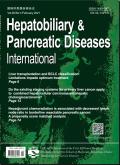Inadvertent perioperative hypothermia and surgical site infections after liver resection
IF 4.4
3区 医学
Q2 GASTROENTEROLOGY & HEPATOLOGY
Hepatobiliary & Pancreatic Diseases International
Pub Date : 2024-12-01
DOI:10.1016/j.hbpd.2023.12.006
引用次数: 0
Abstract
Background
In the overall surgical population, inadvertent perioperative hypothermia has been associated with an increased incidence of surgical site infection (SSI). However, recent clinical trials did not validate this notion. This study aimed to investigate the potential correlation between inadvertent perioperative hypothermia and SSIs following liver resection.
Methods
This retrospective cohort study included all consecutive patients who underwent liver resection between January 2019 and December 2021 at the First Affiliated Hospital, Zhejiang University School of Medicine. Perioperative temperature managements were implemented for all patients included in the analysis. Estimated propensity score matching (PSM) was performed to reduce the baseline imbalances between the normothermia and hypothermia groups. Before and after PSM, univariate analyses were performed to evaluate the correlation between hypothermia and SSI. Multivariate regression analysis was performed to determine whether hypothermia was an independent risk factor for postoperative transfusion and major complications. Subgroup analyses were performed for diabetes mellitus, age > 65 years, and major liver resection.
Results
Among 4000 patients, 2206 had hypothermia (55.2%), of which 150 developed SSI (6.8%). PSM yielded 1434 individuals in each group. After PSM, the hypothermia and normothermia groups demonstrated similar incidence rates of SSI (7.0% vs. 6.3%, P = 0.453), postoperative transfusion (13.7% vs. 13.3%, P = 0.743), and major complications (10.1% vs. 9.0%, P = 0.309). Univariate regression analysis revealed no significant effects of hypothermia on the incidence of SSI in the group with the highest hypothermia exposure [odds ratio (OR) = 1.25, 95% confidence interval (CI): 0.84-1.87, P = 0.266], the group with moderate exposure (OR = 1.00, 95% CI: 0.65-1.53, P = 0.999), or the group with the lowest exposure (OR = 1.11, 95% CI: 0.73-1.65, P = 0.628). The subgroup analysis revealed similar results. Regarding liver function, patients in the hypothermia group demonstrated lower γ-glutamyl transpeptidase (37 vs. 43 U/L, P < 0.001) and alkaline phosphatase (69 vs. 72 U/L, P = 0.016). However, patients in the hypothermia group exhibited prolonged activated partial thromboplastin time (29.2 vs. 28.6 s, P < 0.001).
Conclusions
In our study of patients undergoing liver resection, we found no significant association between mild perioperative hypothermia and SSI. It might be due to the perioperative temperature managements, especially active warming measures, which limited the impact of perioperative hypothermia on the occurrence of SSI.
肝脏切除术后围术期意外低体温和手术部位感染
背景在所有外科手术人群中,围手术期意外低体温与手术部位感染(SSI)发生率增加有关。然而,最近的临床试验并未验证这一观点。这项回顾性队列研究纳入了2019年1月至2021年12月期间在浙江大学医学院附属第一医院接受肝脏切除术的所有连续患者。所有纳入分析的患者均实施了围手术期体温管理。为减少常温组和低温组之间的基线不平衡,进行了估计倾向得分匹配(PSM)。在 PSM 之前和之后,进行了单变量分析,以评估低体温与 SSI 之间的相关性。进行了多变量回归分析,以确定低体温是否是术后输血和主要并发症的独立风险因素。对糖尿病、年龄超过 65 岁和肝脏大部切除术患者进行了分组分析。每组有 1434 人进行了 PSM。PSM 后,低体温组和正常体温组的 SSI(6.3% vs. 7.0%,P = 0.453)、术后输血(13.3% vs. 13.7%,P = 0.743)和主要并发症(9.0% vs. 10.1%,P = 0.309)发生率相似。单变量回归分析显示,在低体温暴露程度最高的组别(几率比 (OR) = 1.25,95% 置信区间 (CI):0.84-1.87,P = 0.266)、暴露程度中等的组别(OR = 1.00,95% CI:0.65-1.53,P = 0.999)或暴露程度最低的组别(OR = 1.11,95% CI:0.73-1.65,P = 0.628)中,低体温对 SSI 的发生率没有显著影响。亚组分析显示了类似的结果。在肝功能方面,低体温组患者的γ-谷氨酰转肽酶(37 U/L对43 U/L,P = 0.001)和碱性磷酸酶(69 U/L对72 U/L,P = 0.016)较低。然而,低体温组患者的活化部分凝血活酶时间延长(29.2 vs. 28.6 s,P < 0.01)。这可能是由于围手术期的体温管理,尤其是积极的保暖措施,限制了围手术期低温对SSI发生的影响。
本文章由计算机程序翻译,如有差异,请以英文原文为准。
求助全文
约1分钟内获得全文
求助全文
来源期刊
CiteScore
5.40
自引率
6.10%
发文量
152
审稿时长
3.0 months
期刊介绍:
Hepatobiliary & Pancreatic Diseases International (HBPD INT) (ISSN 1499-3872 / CN 33-1391/R) a bimonthly journal published by First Affiliated Hospital, Zhejiang University School of Medicine, China. It publishes peer-reviewed original papers, reviews and editorials concerned with clinical practice and research in the fields of hepatobiliary and pancreatic diseases. Papers cover the medical, surgical, radiological, pathological, biochemical, physiological and historical aspects of the subject areas under the headings Liver, Biliary, Pancreas, Transplantation, Research, Special Reports, Editorials, Review Articles, Brief Communications, Clinical Summary, Clinical Images and Case Reports. It also deals with the basic sciences and experimental work. The journal is abstracted and indexed in SCI-E, IM/MEDLINE, EMBASE/EM, CA, Scopus, ScienceDirect, etc.

 求助内容:
求助内容: 应助结果提醒方式:
应助结果提醒方式:


